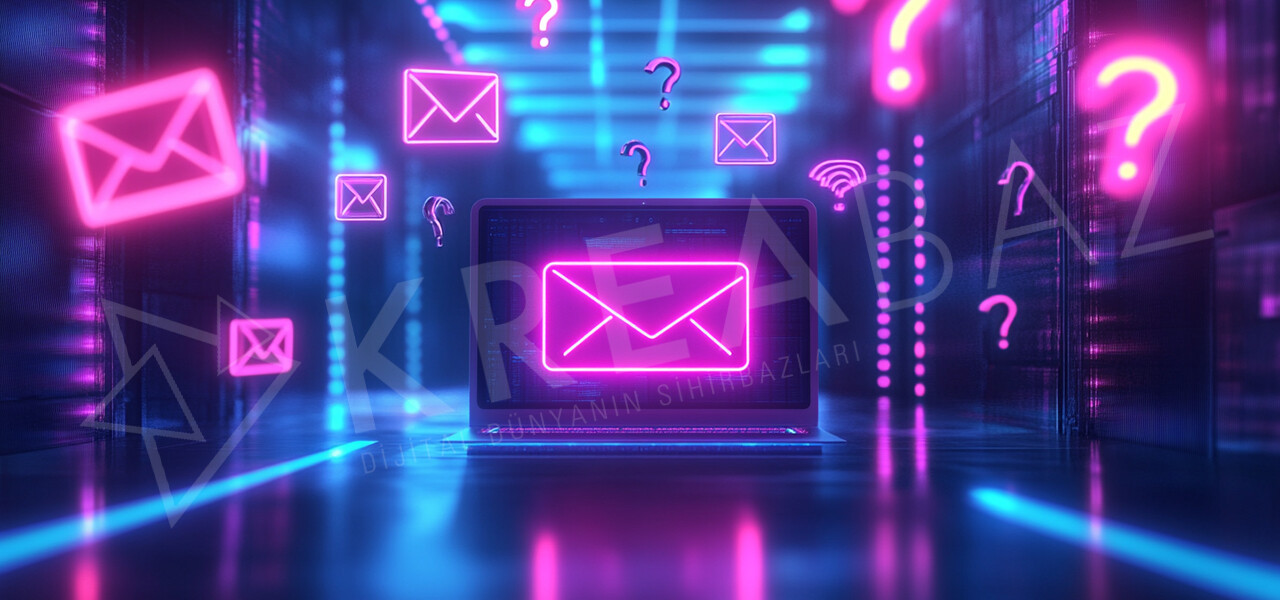
Email marketing is an effective digital marketing method that enables brands to reach their target audience directly. When used with the right strategies, it increases customer loyalty, boosts sales and strengthens brand awareness. However, many questions such as what to consider for a successful email marketing campaign, which tools can be used, and legal limits are still being asked. In this article, we will provide information about frequently asked questions about email marketing. We will also help you make your campaigns more efficient by answering all these questions.
What is e-Mail Marketing?
The first question about email is, of course, what is email marketing? Email marketing is a powerful digital marketing strategy that enables brands to reach customers directly. Companies create email lists to promote their products and services, improve customer relations and increase sales. This method increases brand awareness by establishing one-to-one communication with the target audience, while also helping to strengthen customer loyalty.
Email marketing is one of the most effective ways to reach customers through promotions, announcements, personalized messages and informative content. An effective email marketing strategy delivers valuable content to customers, engaging them and increasing their engagement with the brand. When done correctly, it increases conversion rates and enables the brand to achieve its goals.
Email marketing methods differ according to the purpose of the campaign and the needs of the target audience. The basic email marketing methods are as follows:
- Informative Emails: These are emails that inform users about industry developments, new blog content or news about the brand. They increase brand authority by providing valuable content to customers.
- Promotion and Campaign Emails: These are emails that announce discounts, deals and special offers. They encourage customers to make purchases and increase sales.
- Automated Emails: These are emails that are triggered based on specific actions of users. For example, welcome emails, birthday messages and abandoned cart reminders fall into this category.
- Regular Newsletters: These are emails that regularly deliver brand news, industry updates and useful content to customers. Effective in increasing brand loyalty.
- Recovery Emails: These are emails used to re-engage customers who have not been active for a long time. They can include special offers or reminder messages.
These methods can be adapted according to the goals of the brand and the needs of the customer base to make them more effective.
Email advertising is the marketing emails sent by brands to promote their products and services. It aims to increase conversion rates by offering customized content to the target audience. It usually includes promotional codes, discount offers or new product announcements. A successful email ad includes attention-grabbing headlines and effective CTA (Call-to-Action) buttons.
There are many important points to consider in email marketing. First of all, content suitable for the interests of the target audience should be created. Subject lines directly affect the opening rate of the e-mail. Therefore, it should be interesting and clear. Exaggerated and misleading words should not be used to avoid spam filters. Also, the email content should be short and clear. Personalized messages create a stronger connection with the recipient. Images and buttons should be placed carefully. Mobile compatibility ensures that emails appear smoothly on every device. In addition, performance should be improved by conducting regular analyzes. In this way, we took a quick look at the question “what should be considered in e-mail marketing?”.
Email marketing, like other digital marketing methods, is a service for digital promotion and information. However, as with every platform, email marketing has its differences from other digital marketing methods. “What are the differences between email marketing and other digital marketing methods?” Let’s briefly explain.
Email marketing provides the advantage of communicating directly with the customer. Other digital marketing methods usually aim to reach a wider audience. Social media marketing is used to create engagement. SEO and content marketing focus on driving organic traffic. However, email marketing increases conversion rates by delivering personalized messages. Moreover, its cost is lower than other methods. When used correctly, it strengthens customer loyalty. In addition, email marketing delivers messages directly to the target audience. This provides more effective results compared to other marketing channels.

How to do e-Mail Marketing?
Let’s take a look at how to do email marketing. Email marketing provides effective results with strategic planning. First of all, an e-mail list should be created in accordance with the interests of the target audience. Then, attention-grabbing and professional content should be prepared. Subject lines should be carefully chosen to increase the open rate of emails. Images, buttons and links should be placed at strategic points. Personalized messages increase customer loyalty. It is also important that emails are mobile-friendly. Finally, the performance of campaigns should be analyzed regularly.
Email marketing tools make it easy to manage campaigns. Mailchimp, HubSpot and Sendinblue are among the most popular tools. These platforms offer automated email sending and segmentation features. They also provide advanced analytics to measure campaign performance. They offer features such as email templates, send scheduling and personalization. Choosing the right tool directly affects the success of marketing campaigns. User-friendly interfaces speed up operations and increase efficiency. These tools also provide great convenience for managing email lists.
So, what is a mailing system? A mailing system is a system that manages bulk emailing. It organizes email lists and sends scheduled messages. It also provides performance reports of campaigns. When used correctly, it enables a strong communication with the target audience. Appropriate headers and content should be created to avoid spam filters. User-friendly interfaces make operations more practical. Mailing systems offer great advantages to strengthen customer relationships. In particular, automatic responses and segmentation features speed up business processes.
Perhaps one of the most important things about email is to know how to create an email marketing campaign. For an effective e-mail campaign, a goal must first be set. The purpose of the campaign should be clear. Then, content suitable for the target audience should be prepared. The headings of the emails should be eye-catching and clear. Visuals and CTA buttons should be placed correctly. At the end of the campaign, improvements should be made by analyzing performance. Personalization increases customer engagement. Email design directly affects the user experience. Mobile compatibility is crucial for campaign success.
It is worth explaining what automated email marketing, the heart of email marketing, is and how to use it. Automated email marketing is a system that sends emails based on specific triggers. Welcome emails, birthday greetings and abandoned cart reminders are examples of this method. Personalized automations increase customer loyalty. It also saves time. More effective campaigns can be created with segmentation. Content needs to be of high quality to improve user experience. With the right strategies, automated emails can increase conversion rates.
Now we come to one of the most crucial topics, how to build an email list. The right strategies should be followed to build an effective email list. Adding subscription forms to the website is the first step. Referrals from social media and blog content will expand the list. Collecting emails without user permission increases the risk of spam. Therefore, voluntary subscription should be the basis. The target audience can be better analyzed by segmentation. Personalized emails increase customer satisfaction. Regular cleaning should be done and irrelevant subscribers should be removed from the list.

How to Measure Performance in e-Mail Marketing?
Measuring performance in email marketing is very important for your next email to be more effective and accurate. So, how do you measure performance in email marketing? Some basic metrics are used to measure performance in email marketing. Open rate, click-through rate and conversion rate are the most important indicators. In addition, spam notifications and unsubscribes should also be analyzed. These metrics show how effective the campaign is. Moreover, strategy should be developed by making regular measurements. A/B tests are used to determine which content performs better. As a result of the analysis, more effective marketing methods can be created.
The primary purpose of a mailing is of course to ensure that the mail sent is opened. This is why the question “What is the open rate and how to increase it?” gains great importance. Open rate is a metric that shows how many people opened the email. This rate depends on the subject line and the sender name. Engaging and short subject lines increase the open rate. Also, personalized emails attract more attention. The time of sending is also of great importance. It is useful to send emails when the target audience is most active. The quality of your email list directly affects the open rate. Become a trusted sender to avoid the spam box.
Click-through rate measures clicks on links in an email. A high click-through rate indicates that the email content is effective. Including a strong call-to-action (CTA) increases the click-through rate. It is important that links are prominent and eye-catching. Short and clear content engages the reader more. Mobile compatibility directly affects the click-through rate. Images and buttons should be placed in the right places. If appropriate content is presented to the target audience, the click-through rate increases.
Conversion rate is one of the most important metrics in email marketing. Because the reason for this process is to get conversions. This rate shows whether the people who read the e-mail have taken the desired action. For example, making a purchase or filling out a form can be counted as a conversion. Clear and effective CTAs should be used to increase the conversion rate. Personalized content is more likely to engage users. Providing reliability and easy access increases the conversion rate. Improving the user experience makes emails more effective.
As with every marketing platform, there are A/B tests in email. So, how are email a/b tests done? A/B tests allow you to find the best result by testing different email variations. First, a variable to be tested should be selected. This can be a subject line, image or CTA. Then, one version is sent to one part of the target audience and a different version to another part. The results are analyzed to determine the most successful strategy. Open and click-through rates should be measured with these tests. Regular A/B testing increases campaign success.
The biggest obstacle experienced by e-mails is undoubtedly the high rate of being perceived as spam. Therefore, the question “How can I prevent being marked as spam?” gains great importance. Marking emails as spam reduces the success of marketing campaigns. To avoid this, emails should be sent with permission from the recipients. Subject lines should not be misleading. Using too many capital letters and exclamation marks increases the risk of spam. Unnecessary keywords should not be used in the content. A reliable e-mail provider should be preferred. Allowing users to unsubscribe easily reduces spam notifications. Regular list cleaning is also important.

e-Mail Design and Content
An effective email design and content enhances the user experience and increases open and click-through rates. Images, colors and fonts should be compatible. The message should be short, clear and engaging. The headline is the most important part of the content and should attract attention. Mobile compatibility ensures that the design looks right on every device. CTA (Call-to-Action) buttons that call the user to action should be prominent. There should be a balance between plain text and HTML format. A simple and professional language should be used to avoid spam filters.
Of course, we need to influence people and the people we want to communicate with with our mail. So how can we achieve this? How should an effective e-mail design be? Let’s take a look at this. An effective email design should be simple, legible and mobile-friendly. Visuals and headings that will attract the attention of users should be added. CTA (call-to-action) buttons should be clear and understandable. Texts should be short, concise and written to appeal to the target audience. Colors and fonts should match the brand identity. Instead of using too many design elements, a clear and organized structure should be preferred. Testing and optimization should be done to improve user experience.
HTML emails offer rich designs with images, buttons and styling elements. Plain text emails, on the other hand, are text-only and offer no visual support. HTML emails can be more eye-catching and in line with brand identity. However, some email providers may block HTML formatted messages. Plain text emails can create a more personal and intimate impression. A combination of HTML and plain text is recommended to increase user reach. Both formats should be tested and preferred based on performance.
The email subject is the first factor that encourages the recipient to open it. For this reason, the question “How to Makean Email Subject Interesting?” is very important. Short, clear and intriguing language should be used. Personalization can increase open rates. For example, topics with names or special offers can be more effective. Phrases such as “Limited Time” or “Don’t miss out” can be added to create a sense of urgency. Avoid using too many capital letters or special characters to avoid spam filters. The most effective subject lines should be determined by conducting A/B tests.
Images and videos are important elements that increase the impact of an email. However, excessive use of visuals in email design should be avoided. The question “How should images and videos be used in e-mails?” is of great importance. Images should be in optimized and fast-loading formats. Adding alternative text (alt text) ensures that the content is understood if the images do not load. Videos should not be attached directly to the email, but a link should be provided instead. Buttons and call-to-action elements should be placed next to the images. The compatibility of the visuals with the brand identity increases credibility.

Personalized Content in e-Mail Marketing
Personalized content in email marketing increases customer interest and strengthens engagement. Emails that start with the user’s name appear more sincere. Offering recommendations based on past purchases or behavior increases conversion rates. Dynamic content helps deliver customized messages to each user. Segmentation is essential to deliver the right message to the right person. Automation tools make it easier to send personalized emails on time. Authentic and valuable content keeps subscribers opening emails. A natural and balanced approach should be preferred over excessive personalization.
Personalized emails are an effective strategy to increase customer loyalty. Users are more engaged when they receive personalized messages. Content based on first name, last name or past purchases is more successful. Campaigns based on individual interests instead of general messages convert more. Personalization increases email open and click-through rates. Personalization with a data-driven strategy increases customer satisfaction.
Customer segmentation enables email marketing to reach the right audience. It is possible to group users by age, location, purchase history or interests. Segmented emails achieve higher open and conversion rates. Personalized campaigns should be created by analyzing behavioral data. Different content should be offered to new customers and different content to loyal customers. The email list should be updated regularly and the segmentation strategy should be optimized.
Another important question is the use of dynamic content. How does dynamic content work in email campaigns? Dynamic content allows emails to be customized specifically for the recipient. Content can be shown based on the user’s location, past behavior or interests. For example, if a customer has previously reviewed a particular product, relevant recommendations can be presented. This method increases engagement rates and delivers valuable content to the user. E-commerce sites can use dynamic content for abandoned cart reminders or personalized discounts. Thanks to dynamic content, a customized experience can be offered to each recipient.

Differences Between B2B and B2C e-Mail Marketing
B2B and B2C email marketing are different in terms of target audience and strategy. In B2B marketing, content should be more professional and informative. In B2C, the focus is on emotional connection and quick sales. While B2B emails usually reach decision makers, B2C emails address the end consumer directly. The buying process is longer in B2B and faster in B2C. In B2B, detailed content is important, while in B2C, visualization and short messages are effective. Therefore, the differences between B2B and B2C email marketing are very important.
B2B email marketing requires professional language and detailed content. Valuable information about the sector should be provided to reach decision makers. Content aimed at building long-term relationships should be preferred. B2B customers compare prices and features, so transparent information should be provided. Customized emails should be sent to the right people using automation and segmentation. Customer interest should be maintained with follow-up e-mails and the sales process should be supported.
B2C email marketing should be about taking quick action. Emotionally engaging, attention-grabbing and short messages are effective. Personalized campaigns and discount offers increase conversion rates. Visuality should be at the forefront and content that leads to a clear call should be prepared. Emails should be sent at regular intervals in order not to lose customer interest. Expressions that create a sense of urgency can accelerate sales.
A professional tone should be used when sending e-mails to corporate customers. The message should be clear and understandable, not unnecessarily long. The subject line should be interesting but not overly ambitious. Content should be customized according to customer needs. The timing of the email should be appropriate for business hours. Avoid unnecessary sales language to avoid spam filters. Call to action buttons (CTA) should be clearly and professionally designed.

Strategies that Increase Success in e-Mail Marketing
Applying the right strategies is essential for success in email marketing. First of all, it is necessary to analyze the target audience well. Segmentation according to the interests and behaviors of the recipients provides a great advantage. The right segments make it possible to deliver the message more effectively. Personalized content strengthens customer loyalty. The use of names and special offers increase open rates. Creating an effective subject line is also very important. An engaging, short and clear title attracts the attention of buyers.
Mobile-friendly designs are a must nowadays. Displaying emails properly on every device improves the user experience. Simple, clear and easy-to-read content brings more engagement. Emails should have a clear call to action (CTA). Clear buttons directing the recipient increases conversion rates. Regular A/B testing helps determine the best strategy. Different subject lines, design elements and content types should be tested.
Automation tools provide great convenience in email marketing. Sending automated emails based on specific triggers increases customer satisfaction. For example, welcome emails, abandoned cart reminders or special occasion greetings. To avoid spam filters, you need to be a trusted sender. It is important not to send emails without people’s permission and to avoid unnecessary capitalization and exclamation marks. In addition, following the analytics regularly and constantly improving the strategy is critical for successful email marketing.
E-Mail Marketing Mistakes and What to Avoid
While email marketing is an effective strategy, some mistakes can negatively affect the success of campaigns. For this reason, it is worth taking a look at email marketing mistakes and what to avoid.
Reaching the wrong target audience leads to low open and click-through rates. Lack of personalization causes recipients to lose interest. Sending the same content to everyone can negatively impact the customer experience. Sending emails too frequently causes subscribers to become annoyed and unsubscribe. If the design is not mobile-friendly, it reduces readability. Also, too long and complex content weakens the impact of the message. Uninteresting subject lines reduce open rates. Not including a clear call to action (CTA) in emails negatively affects conversion rates. If the sender’s name and email address do not appear trustworthy, recipients may delete the message without opening it. Determining the strategy without measurement leads to repeating mistakes.
One of the most common mistakes in email marketing is incorrect targeting. Sending the same content to everyone causes recipients to lose interest. Overly sales-oriented content leads to loss of trust. Using complex or long paragraphs in emails reduces readability. Misleading subject lines cause a loss of trust.
Timing errors are also a big problem. Sending at times when recipients are unlikely to open the email will result in a failed campaign. Lack of mobile compatibility makes the email look bad on small screens. Misuse of automation can result in the wrong messages going to the wrong people. Emails sent without testing may contain errors and look unprofessional.
If emails end up in the spam folder, it greatly negatively affects the success of the campaign. First of all, it is important not to send emails without the recipients’ permission. Sending emails to registered and approved subscribers prevents being marked as spam. Avoid using capital letters and unnecessary exclamation marks in subject lines.
Spam filters can detect overly sales-oriented words. Phrases such as “free”, “buy now”, “don’t miss out” should be used carefully. The ratio of images and text in the e-mail should be balanced. Emails consisting only of images can be caught in the spam filter. It is important that the sender’s e-mail address is reliable. Personalized and relevant content reduces the risk of spam.
It is useful to regularly collect feedback and analyze spam rates. To prevent recipients from using the “mark as spam” option, the unsubscribe link must be clear and accessible. Sender identity should be verified using authentication protocols such as SPF, DKIM and DMARC.
Reaching the right audience is the key to success in email marketing. Incorrect targeting causes recipients to lose interest and unsubscribe. First, email lists should be segmented. Customers should be grouped according to their interests, behaviors and previous interactions.
Personalized content supports accurate targeting. Providing recipient-specific offers and suggestions increases engagement. Analyzing feedback from subscribers helps identify the right strategies. Automated email series can provide content tailored to the needs of recipients.
Data should be analyzed regularly using email marketing tools. Open and click-through rates are valuable for measuring recipient interest. A/B tests can be used to determine the best targeting methods. Finally, email lists should be updated regularly and people who have lost interest should be purged.

Your Questions About e-Mail Marketing
Email marketing is a powerful tool that enables brands to communicate directly with their customers. However, if the right strategies are not implemented, it can be difficult to achieve the desired results. We have compiled the most frequently asked questions and prepared the most effective answers. From campaign performance to personalization techniques, you can find all the details about email marketing here. In this guide, you can find answers to many questions about email marketing, from legal regulations to content strategies. We’ve covered topics such as email permissions, mass mailing, CTA buttons and methods to increase engagement in detail. We’ve also explained the best timing of emails, mobile compatibility and how to optimize them according to customer behavior. Be sure to evaluate these tips to strengthen your email marketing strategies. If you want to make your email marketing process more efficient, this section of questions about email marketing is just what you are looking for.
It is useful to start by explaining what mail permission is. Mail permission is a user’s consent to receive emails. This permission is legally required when doing email marketing. Emails sent without the user’s explicit consent are considered spam. Mail permissions are usually obtained through subscription forms on websites. By asking users if they want to receive your emails, you can build a trusted list. Also, permission marketing increases customer trust and brings more effective results.
Building an effective email list is perhaps the backbone of this business. Correctly created, targeted and selected emails will greatly increase conversion rates. So, how to create the right email list? Voluntary subscription should be the basis for an email list. Adding a sign-up form to your website is the first step. Email registration should be encouraged with social media and blog content. Offering promotions that will attract the attention of the target audience can be effective. Instead of buying an email list, it is more efficient to grow it organically. Lists should be made more effective by segmentation. Cleaning the list at regular intervals increases efficiency.
Building an email list suitable for the target audience directly affects marketing success. First, demographic data and interests should be analyzed. Different groups should be created by segmentation. In registration forms, users can be asked to select their interests. Personalized emails ensure higher engagement. The list should be updated regularly. When emails meet user expectations, unsubscribes decrease.
The email list should be regularly updated and cleaned. Subscribers with low engagement rates should be identified and re-engaged. Emails that are not opened for a long time should be removed from the list. Invalid or incorrect e-mail addresses should be cleaned. Segmentation should be done according to subscribers’ preferences. Users should be allowed to update their subscription preferences. By conducting regular analysis, the effectiveness of the list should be increased.
Provide quality and valuable content to reduce unsubscribes. Avoid sending unnecessary emails to users frequently. Send personalized and engaging messages. Users should be given the opportunity to choose the type and frequency of content. Mobile compatibility is an important factor in reducing unsubscribes. The unsubscribe process should be easy but deliberate. Strategies should be updated taking into account user feedback.
Mass mailing is possible as long as it complies with legal regulations. Laws such as GDPR and KVKK prohibit sending e-mails without permission. The explicit consent of the people on the e-mail list must be obtained. Mass mailings without permission can lead to spam complaints and legal sanctions. Therefore, it is important to act within the legal framework when doing email marketing.
The email sending capacity depends on the marketing tool used. Free tools usually offer a set limit per day. Platforms like Mailchimp allow for more sending with paid plans. However, sending too many emails can increase the risk of spam. Sending frequency directly affects the customer experience. It is important to act with a balanced strategy. A sending plan should be created in order not to lose the interest of the target audience. Campaign results should be analyzed to determine the ideal sending frequency.
Compliance with GDPR and KVKK rules is mandatory in email marketing. It is necessary to obtain explicit consent from the user and process data transparently. Subscription forms should include explicit consent text and users should be able to unsubscribe at any time. In addition, personal data must be secured and not shared with third parties. Complying with legal regulations protects your brand’s reputation and helps you avoid penalties.
CTA buttons directly affect the conversion rate of your emails. A clear and concise message should be used for an effective CTA. Phrases that will mobilize the user should be preferred. For example, powerful phrases such as “Download Now” or “Don’t Miss the Deal” work well. The color, size and position of the button should also be eye-catching. Aligning the CTA with the email content increases the conversion rate.
In email marketing, content should be personalized to keep users engaged. Offering personalized campaigns and recommendations increases engagement. In addition, attention-grabbing subject lines and engaging visuals should be used. It is important to create content that provides value to the user. Emails with surveys, discounts or special offers engage users and increase their conversion.
Personalized emails have higher open and conversion rates than standard messages. Emails that include users’ names and are organized according to their interests attract more attention. It is also effective to segment and provide specific content for certain groups. Delivering content based on a user’s past behavior increases engagement and customer loyalty.
The best timing of emails depends on the target audience. In general, emails sent on weekday mornings are more likely to be opened. For business emails, Tuesdays and Thursdays are ideal. For B2C marketing, weekends may work better. Conducting A/B tests when determining the timing will help you get the best results.
Effective email content should be short, concise and attention-grabbing. The title should be written in a way that encourages the user to open it. The content should focus directly on the subject and avoid unnecessary details. Images and videos should be used in a balanced way and the message should be conveyed clearly. Also, adding a strong CTA increases conversion rates.
Emailing old customers again is an effective way to win them back. Offering special offers to customers who haven’t interacted with you for a long time can work. You can use personalized content to bring them back to your brand. However, sending emails too often can be counterproductive. It is important to strike a balance.
The open rate of emails varies by day and time. In general, Tuesday, Wednesday and Thursday give the best results. 08:00 – 10:00 in the morning and 13:00 – 15:00 in the afternoon are the times when emails are opened the most. However, it will be more effective to determine the best time by analyzing the behavior of your target audience.
The dynamics are different for each sector. As such, the mail times for these sectors also vary. So, what are the best email sending times for different sectors For the B2B sector, weekday morning hours are more suitable. Weekends and evening hours can be more efficient for e-commerce. In the health and finance sectors, business days provide more conversions. You should run tests to determine the appropriate timeframe for your industry.
Adjusting email timing according to customer behavior increases engagement. Users’ past open and click data should be analyzed. Segmentation should be done to determine the appropriate timing for each group. For example, sending emails in the evening may be more effective for users who are active at night.
Today, it is imperative that emails are mobile-friendly. The majority of users check their emails from mobile devices. Emails that are not mobile-friendly negatively affect open and conversion rates. Designs should be prepared for small screens.
A simple and legible structure should be preferred for mobile-friendly e-mail design. Large fonts, single-column designs and optimized images should be used. CTA buttons should be placed appropriately for touch screens. Also, unnecessary elements should be reduced for fast loading of emails.
Emails should be short and clear for mobile users. Subject lines should be eye-catching and clear. Use a simple and effective design that loads quickly. Mobile-friendly CTAs and personalized content increase conversion rates.








